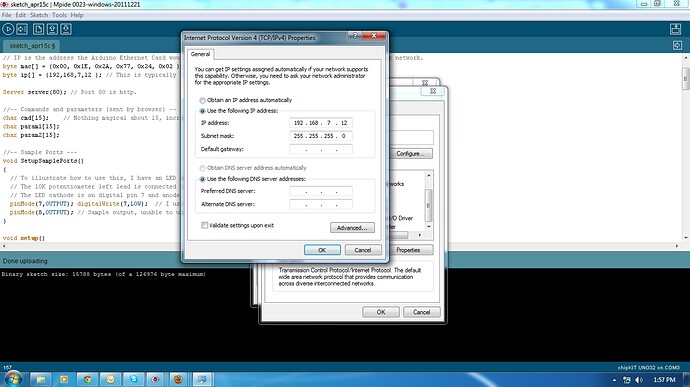Dear all,
I am starting new project using Ethernet. I need step for executing web server application. I have Certain data to be monitored on web server.
I have these many data to be monitored on webserver
- date and time
2)latitude
3)longitude
4)Desired angle
5)actual angle
etc
Action to be control:
Motor forward and reverse
value to be change:
1)date and time
2)angles - limit of wind speed.
Question :
- is it possible to do using web server application??
- Basic steps for configure web server
3)How to create our own control tags. see youtube 2
Sheild i am using.
Here i have added one video where we can fine any change in analog value also change in web server. How to make it. Is there any software available to create tags.
Testing code
#include <SPI.h>
#include <Ethernet.h>
#include<string.h>
// MAC address can be anything that is unique within your network.
// IP is the address the Arduino Ethernet Card would respond to. It needs to be an unused address within your network.
byte mac[] = {0x00, 0x1E, 0x2A, 0x77, 0x24, 0x02 };
byte ip[] = {192,168,7,12 }; // This is typically 10.0.0.x
Server server(80); // Port 80 is http.
//-- Commands and parameters (sent by browser) --
char cmd[15]; // Nothing magical about 15, increase these if you need longer commands/parameters
char param1[15];
char param2[15];
//-- Sample Ports ---
void SetupSamplePorts()
{
// To illustrate how to use this, I have an LED and a Potentiometer.
// The 10K potentiometer left lead is connected to GND, right lead to +5V, and middle lead to Analog 0.
// The LED cathode is on digital pin 7 and anode is on pin 8.
pinMode(7,OUTPUT); digitalWrite(7,LOW); // I use this pin as GND for the LED.
pinMode(8,OUTPUT); // Sample output, unable to use built-in LED at pin 13 because Ethernet Shield uses pins 10,11,12,13.
}
void setup()
{
Ethernet.begin(mac, ip);
server.begin();
Serial.begin(57600);
SetupSamplePorts();
}
#define bufferMax 128
int bufferSize;
char buffer[bufferMax];
void loop()
{
Client client = server.available();
if (client)
{
WaitForRequest(client);
ParseReceivedRequest();
PerformRequestedCommands();
client.stop();
}
}
void WaitForRequest(Client client) // Sets buffer[] and bufferSize
{
bufferSize = 0;
while (client.connected()) {
if (client.available()) {
char c = client.read();
if (c == '\n')
break;
else
if (bufferSize < bufferMax)
buffer[bufferSize++] = c;
else
break;
}
}
PrintNumber("bufferSize", bufferSize);
}
void ParseReceivedRequest()
{
Serial.println("in ParseReceivedRequest");
Serial.println(buffer);
//Received buffer contains "GET /cmd/param1/param2 HTTP/1.1". Break it up.
char* slash1;
char* slash2;
char* slash3;
char* space2;
slash1 = strstr(buffer, "/") + 1; // Look for first slash
slash2 = strstr(slash1, "/") + 1; // second slash
slash3 = strstr(slash2, "/") + 1; // third slash
space2 = strstr(slash2, " ") + 1; // space after second slash (in case there is no third slash)
if (slash3 > space2) slash3=slash2;
PrintString("slash1",slash1);
PrintString("slash2",slash2);
PrintString("slash3",slash3);
PrintString("space2",space2);
// strncpy does not automatically add terminating zero, but strncat does! So start with blank string and concatenate.
cmd[0] = 0;
param1[0] = 0;
param2[0] = 0;
strncat(cmd, slash1, slash2-slash1-1);
strncat(param1, slash2, slash3-slash2-1);
strncat(param2, slash3, space2-slash3-1);
PrintString("cmd",cmd);
PrintString("param1",param1);
PrintString("param2",param2);
}
void PerformRequestedCommands()
{
if ( strcmp(cmd,"digitalWrite") == 0 ) RemoteDigitalWrite();
if ( strcmp(cmd,"analogRead") == 0 ) RemoteAnalogRead();
}
void RemoteDigitalWrite()
{
int ledPin = param1[0] - '0'; // Param1 should be one digit port
int ledState = param2[0] - '0'; // Param2 should be either 1 or 0
digitalWrite(ledPin, ledState);
//-- Send response back to browser --
server.print("D");
server.print(ledPin, DEC);
server.print(" is ");
server.print( (ledState==1) ? "ON" : "off" );
//-- Send debug message to serial port --
Serial.println("RemoteDigitalWrite");
PrintNumber("ledPin", ledPin);
PrintNumber("ledState", ledState);
}
void RemoteAnalogRead()
{
// If desired, use more server.print() to send http header instead of just sending the analog value.
int analogPin = param1[0] - '0'; // Param1 should be one digit analog port
int analogValue = analogRead(analogPin);
//-- Send response back to browser --
server.print("A");
server.print(analogPin, DEC);
server.print(" is ");
server.print(analogValue,DEC);
//-- Send debug message to serial port --
Serial.println("RemoteAnalogRead");
PrintNumber("analogPin", analogPin);
PrintNumber("analogValue", analogValue);
}
void PrintString(char* label, char* str)
{
Serial.print(label);
Serial.print("=");
Serial.println(str);
}
void PrintNumber(char* label, int number)
{
Serial.print(label);
Serial.print("=");
Serial.println(number, DEC);
}[tt][tt][/tt][/tt]






